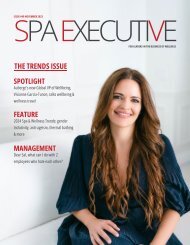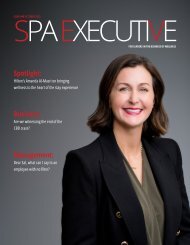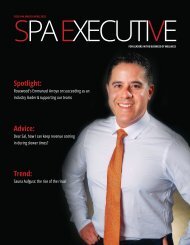Spa Executive_MARCH-2021-V3
You also want an ePaper? Increase the reach of your titles
YUMPU automatically turns print PDFs into web optimized ePapers that Google loves.
TECHNOLOGY<br />
NATURE HEALS<br />
SCIENTIFIC EVIDENCE<br />
SUPPORTING THE USE OF<br />
3 TOUCHLESS THERAPIES<br />
More spas are offering touchless therapies to accommodate needs for physical<br />
distancing. Here’s scientific evidence to support their use.<br />
As we continue to navigate the COVID-19<br />
pandemic, the spa, wellness and hospitality world<br />
has been adopting touchless guest experiences.<br />
Many people want to travel, enjoy self-care, and<br />
take part in wellness without the traditional hightouch<br />
element. Companies are rising to meet this<br />
demand with contactless options for guests.<br />
Among these are spa treatments and therapies,<br />
and other wellness experiences that allow people<br />
to keep their distance from others while enhancing<br />
health and wellbeing.<br />
These include reiki, vibrational sound healing,<br />
and forest bathing, aka shinrin yoku. Guests<br />
may be less familiar with these modalities than<br />
more traditional touch therapies, like massage<br />
and hands-on body work, but that doesn’t mean<br />
they don’t work. Here is a roundup of scientific<br />
evidence demonstrating the potential benefits of<br />
three touchless therapies: reiki, sound healing, and<br />
shinrin yoku.<br />
1. REIKI<br />
A form of energy healing that originated in Japan,<br />
reiki is one of the best known touchless therapies.<br />
It does not involve touch and is said to work<br />
through the transfer of universal energy when the<br />
practitioner holds their palms over the recipient.<br />
The word comes from the Japanese<br />
words “rei” (universal) and “ki” (life<br />
energy) and stems from a phrase<br />
meaning “mysterious atmosphere,<br />
miraculous sign.” The belief is that<br />
stagnant energy is associated with<br />
physical illness and emotional pain<br />
and reiki improves the energy flow,<br />
improving relaxation, reducing pain,<br />
speeding healing, and more.<br />
Reiki has many advocates and<br />
is increasing in popularity. Reiki<br />
techniques include centering,<br />
clearing, and extracting harmful<br />
energies.<br />
Scientific evidence<br />
A review of available clinical studies<br />
found “reasonably strong” evidence<br />
that Reiki is more effective than<br />
placebo.” The authors wrote, “Reiki<br />
is a safe and gentle ‘complementary’<br />
therapy that activates the<br />
parasympathetic nervous system to<br />
heal body and mind. It has potential<br />
for broader use in management<br />
of chronic health conditions, and<br />
possibly in postoperative recovery.”<br />
In a 2011 study, subjects who<br />
received Reiki demonstrated greater<br />
health and mood benefits than those<br />
who did not. Separate research found<br />
that participants with high anxiety<br />
and/or depression who received six,<br />
blind 30-minute sessions over a two<br />
to eight weeks showed progressive<br />
improvement in overall mood, while<br />
no change was seen in the controls.<br />
Another study found that reiki acutely<br />
improved physical and psychological<br />
symptoms associated with many<br />
health conditions, including pain,<br />
depression, anxiety, tiredness,<br />
drowsiness, nausea, shortness of<br />
breath, appetite, and overall wellbeing.<br />
The authors wrote: “Reiki can<br />
provide immediate relief for many<br />
health conditions and is used for<br />
this purpose inside and outside of the<br />
hospital setting.”<br />
2. SOUND HEALING<br />
Sound healing is a practice that uses<br />
voice or sacred instruments like gongs,<br />
Tibetan singing bowls, and tuning forks<br />
to create vibrational sounds believed<br />
to alter brain waves, release energetic<br />
blockages, and induce states of ease<br />
and harmony. Advocates believe it<br />
can relieve ailments like anxiety and<br />
insomnia, synchronize brain waves,<br />
and restore vibratory frequencies of<br />
cells.<br />
Gong Master Martha Collard of Red<br />
Doors Studio told Destination Deluxe<br />
that sound can shift frequencies “from<br />
low energy of guilt and fear to higher<br />
vibrations of love and joy.” Malbert Lee,<br />
a Hong Kong-based Crystal Bowl and<br />
Gong Master, explained, “The adult<br />
body is 75% water, and water is a great<br />
conductor for sound vibration.”<br />
Scientific evidence<br />
A 2017 study found that subjects who<br />
participated in Tibetan singing bowl<br />
meditation reported significantly lower<br />
tension, anger, fatigue, and depressed<br />
mood. Interestingly, “participants who<br />
were previously naïve to this type of<br />
meditation experienced a significantly<br />
greater reduction in tension compared<br />
with participants experienced in this<br />
meditation.” Feelings of spiritual wellbeing<br />
also significantly increased.<br />
Another 2017 study found that the use<br />
of low-frequency sound stimulation<br />
resulted in a statistically and clinically<br />
relevant improvement in Fibromyalgia<br />
symptoms and that subjects showed<br />
no adverse effects. Study author Lee<br />
Bartel told the Globe and Mail that<br />
the most appealing aspects of sound<br />
therapy are that it’s low cost, can be<br />
administered almost anywhere, and<br />
doesn’t have the failure rates or side<br />
effects of medications.<br />
“It is something that people can<br />
do easily,” he said. “In the future, if<br />
we continue to see positive results,<br />
the medical community may start<br />
prescribing it.”<br />
3. FOREST BATHING<br />
(SHINRIN YOKU)<br />
Like reiki, forest bathing originated<br />
in Japan. It is the simple practice of<br />
mindfully immersing oneself in nature.<br />
“shinrin” means forest and “yoku”<br />
means bath. It’s described as simply<br />
being in nature and connecting with<br />
nature through sight, hearing, taste,<br />
smell and touch.<br />
Scientific evidence<br />
A review of 28 papers found that<br />
forest bathing activities might<br />
improve cardiovascular function and<br />
blood pressure and have a positive<br />
impact on metabolism, immunity and<br />
inflammation. The research noted<br />
significant enhancement of emotional<br />
state and alleviation of anxiety and<br />
depression, and concluded that forest<br />
bathing may significantly improve<br />
physical and psychological health.<br />
Separate research found that middleaged<br />
Tokyo office workers who walked<br />
in a forest setting were significantly<br />
less anxious, slept better, and slept<br />
longer than when they walked in a nonforest<br />
setting. Interestingly, afternoon<br />
walks were more beneficial than<br />
morning walks.<br />
Finally, a study of 20,000 people found<br />
that those who spent two hours a week<br />
in green spaces were substantially<br />
more likely to report good health and<br />
psychological well-being than those<br />
who did not. Two hours was the key.<br />
The study found there were no benefits<br />
for people who didn’t meet that<br />
threshold.<br />
<strong>Spa</strong> <strong>Executive</strong> <strong>MARCH</strong> <strong>2021</strong> ISSUE - 6 - - 7 - <strong>Spa</strong> <strong>Executive</strong> <strong>MARCH</strong> <strong>2021</strong> ISSUE


















